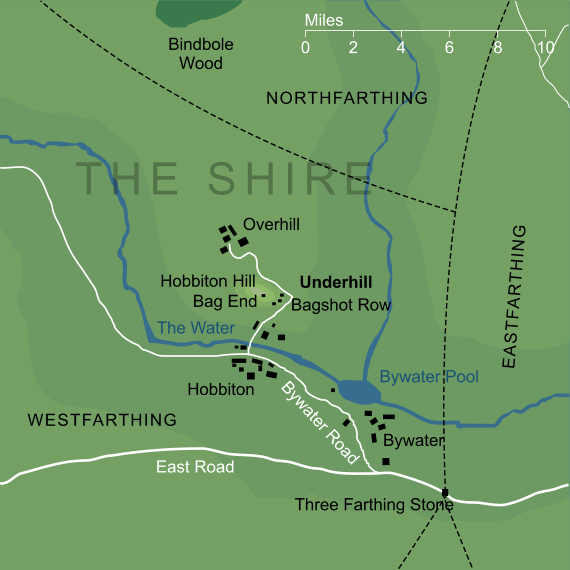- Cities and buildings
- Fields, plains and deserts
- Forests
- Hills and mountains
- Islands and promontories
- Lands, realms and regions
- Rivers and lakes
- Seas and oceans


|
||
|


Which personality type are you?
Take the Free mydiscprofile Personality Test to discover your core personality and your ideal job.   Which personality type are you? |
|
Dates
Location
Race
Culture
Family
The village was most closely associated with the Baggins family
Meaning
'Under (Hobbiton) Hill'
Indexes: About this entry:
|
UnderhillThe hamlet under Hobbiton Hill
That part of the town of Hobbiton that lay on (and within) the slopes of Hobbiton Hill. Its most important smial was the large and luxurious Hobbit-hole known as Bag End, but the row of smaller holes on the lower slopes known as Bagshot Row would also have been part of Underhill. The further extents of the hamlet are less clear. The name may have been used only of the smials burrowed into the Hill itself, or might have extended to cover all of Hobbiton southward of Hobbiton Hill (as opposed to Overhill, a small settlement that lay northward of the Hill. When Frodo Baggins set out from Bag End, on Gandalf's advice he adopted the village name as his alias, calling himself 'Mr. Underhill'. Using this name in Bree, many miles from Hobbiton, he discovered that an Underhill family existed in the Bree-land. These Underhills lived in Staddle on the slopes of the Bree-hill. In the case of these Bree-hobbits, the name presumably came from the fact that they lived under the Bree-hill (that is, there would have been no connection to the place named Underhill in the Shire). The first appearance of the name Underhill is early in The Hobbit, where Bilbo Baggins, after briefly being tempted by the thought of adventure, soon reverts to '...plain Mr. Baggins of Bag-End, Under-Hill, again.' (The Hobbit 1, An Unexpected Party; later editions use the standardised spelling 'Underhill'). Without further explanation, and given that all the reader has been told at this point is that Bag End lay under the Hill, this could easily read like a simple description of the Hobbit-hole. Later in the same book, chapter 4 is titled Over Hill and Under Hill (the 'hill' here actually referring to the Misty Mountains). Later still, Bilbo tells Smaug, 'We came over hill and under hill, by wave and wind, for Revenge.' (The Hobbit 12, Inside Information). All these various iterations of the same idea within The Hobbit perhaps later inspired the pair of villages later established in The Lord of the Ring: Overhill and Underhill. See also...Indexes: About this entry:
For acknowledgements and references, see the Disclaimer & Bibliography page. Original content © copyright Mark Fisher 1998, 2001, 2010, 2017, 2023. All rights reserved. For conditions of reuse, see the Site FAQ. Website services kindly sponsored by Discus from Axiom Software Ltd.Discus provides all the tools you need to build DISC personality profiling into your own Website. |